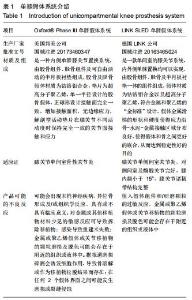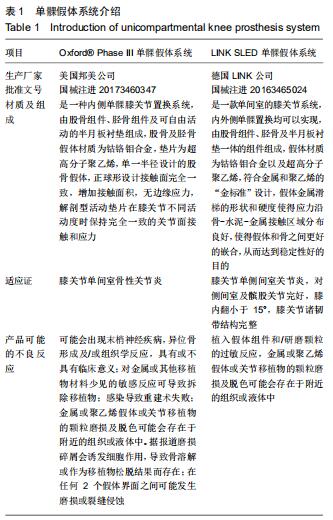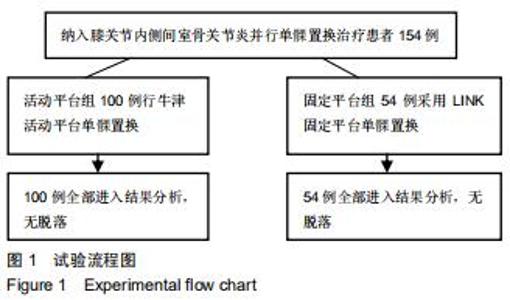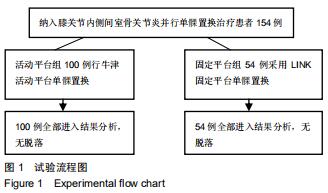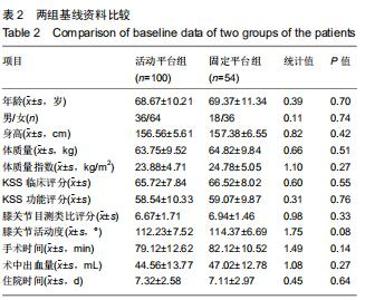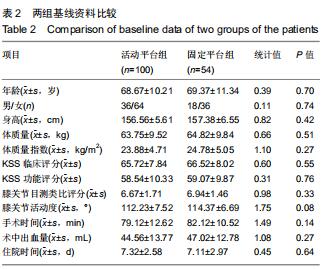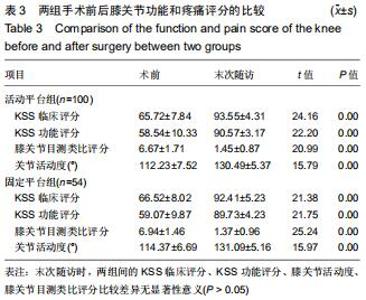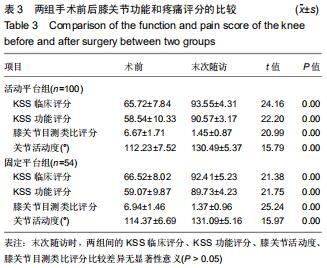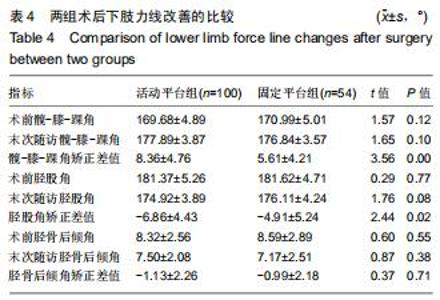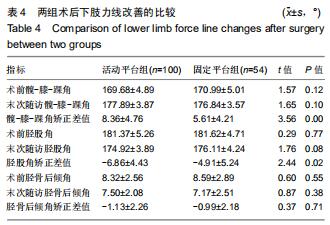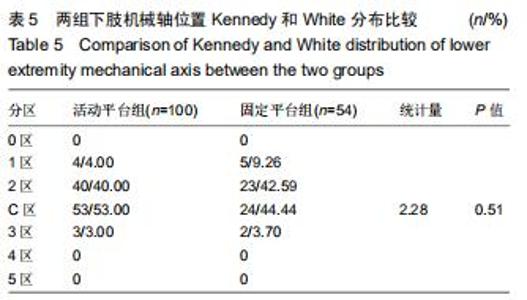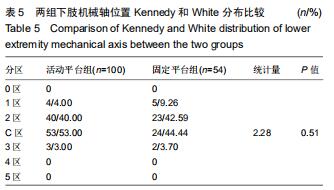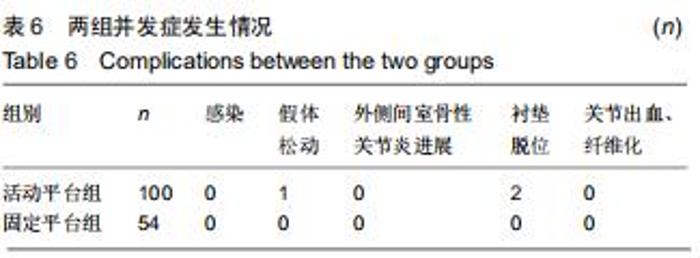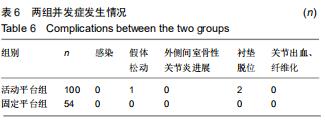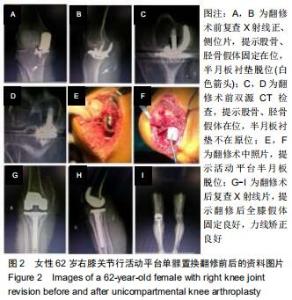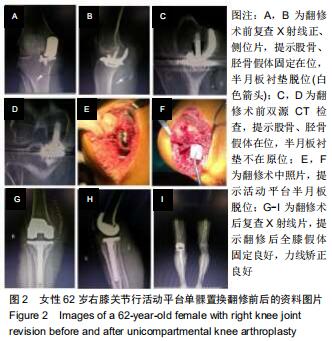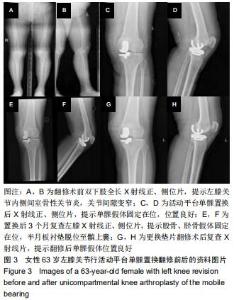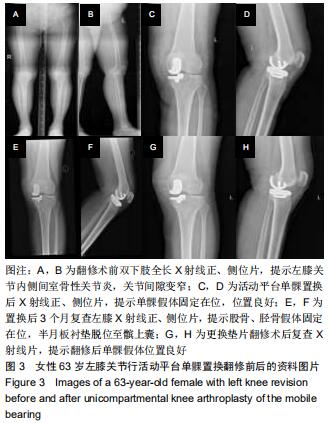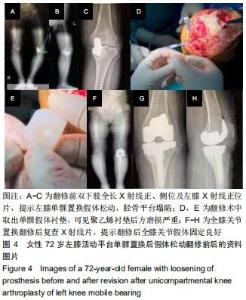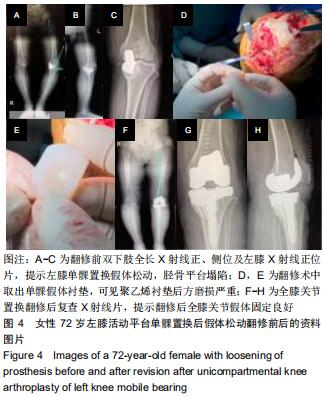Chinese Journal of Tissue Engineering Research ›› 2020, Vol. 24 ›› Issue (36): 5785-5792.doi: 10.3969/j.issn.2095-4344.2930
Previous Articles Next Articles
Mobile bearing and fixed bearing unicompartmental knee arthroplasty for medial knee osteoarthritis
Liu Shaohua1,2, Zhou Guanming1,2, Chen Xicong1,2, Xiao Keming1,2, Cai Jian1,2, Zeng Huiliang1,2
- 1Foshan Hospital of Traditional Chinese Medicine Affiliated to Guangzhou University of Chinese Medicine, Foshan 528000, Guangdong Province, China; 2Department of Arthrosis, Foshan Hospital of Traditional Chinese Medicine, Foshan 528000, Guangdong Province, China
-
Received:2020-02-29Revised:2020-03-10Accepted:2020-04-11Online:2020-12-28Published:2020-10-27 -
Contact:Zhou Guanming, Chief physician, Associate professor, Foshan Hospital of Traditional Chinese Medicine Affiliated to Guangzhou University of Chinese Medicine, Foshan 528000, Guangdong Province, China; Department of Arthrosis, Foshan Hospital of Traditional Chinese Medicine, Foshan 528000, Guangdong Province, China -
About author:Liu Shaohua Doctoral candidate, Attending physician, Foshan Hospital of Traditional Chinese Medicine Affiliated to Guangzhou University of Chinese Medicine, Foshan 528000, Guangdong Province, China; Department of Arthrosis, Foshan Hospital of Traditional Chinese Medicine, Foshan 528000, Guangdong Province, China -
Supported by:the Scientific Research Project of Guangdong Traditional Chinese Medicine Bureau, No. 20192095; the Research on Medical Science and Technology in Guangdong Province, No. 20161181228306
CLC Number:
Cite this article
Liu Shaohua, Zhou Guanming, Chen Xicong, Xiao Keming, Cai Jian, Zeng Huiliang. Mobile bearing and fixed bearing unicompartmental knee arthroplasty for medial knee osteoarthritis[J]. Chinese Journal of Tissue Engineering Research, 2020, 24(36): 5785-5792.
share this article
|
[1] MACINTOSH DL, HUNTER GA. The use of the hemi-arthroplasty prosthesis for advanced osteoarthritis and rheumatoid arthritis of the knee.J Bone Joint Surg Br. 1972;54(2):244-255.
[2] 鲁宁,杨阳.活动平台单髁置换修复膝关节内侧间室骨关节炎:4-6年随访[J].中国组织工程研究,2016,20(31):4575-4581.
[3] VAN DER LIST JP, MCDONALD LS, PEARLE AD. Systematic review of medial versus lateral survivorship in unicompartmental knee arthroplasty.Knee. 2015;22(6):454-460.
[4] ISAAC SM, BARKER KL, DANIAL IN, et al. Does arthroplasty type influence knee joint proprioception? A longitudinal prospective study comparing total and unicompartmental arthroplasty. Knee. 2007;14(3):212-217.
[5] PRICE AJ, WAITE JC, SVARD U. Long-term Clinical Results of the Medial Oxford Unicompartmental Knee Arthroplasty.Clin Orthop Relat Res.2005;4(35):171-180.
[6] LIDDLE AD, JUDGE A, PANDIT H, et al. Adverse outcomes after total and unicompartmental knee replacement in 101,330 matched patients:a study of data from the National Joint Registry for England and Wales.Lancet. 2014;384(9952):1437-1445.
[7] NEWMAN J, PYDISETTY RV, ACKROYD C. Unicompartmental or total knee replacement:the 15-year results of a prospective randomised controlled trial.J Bone Joint Surg Br. 2009;91(1): 52-57.
[8] PRICE AJ, WEBB J, TOPF H, et al. Rapid recovery after Oxford unicompartmental arthroplasty through a short incision.J Arthroplasty.2001;16(8):970-976.
[9] 鲍哲明,孙海宁,王冰,等.膝关节单髁置换活动与固定平台短期疗效分析[J].生物骨科材料与临床研究,2018,15(3):57-65.
[10] BONUTTI PM, DETHMERS DA. Contemporary Unicompartmental Knee Arthroplasty: Fixed vs Mobile Bearing.J Arthroplasty. 2008; 23(7-supp-S):24-27.
[11] 卢明峰,胡广兵,李泽晖,等.LINK 固定平台与 Oxford 活动平台单髁置换治疗膝内侧单间室骨性关节炎的对比[J].中国组织工程研究, 2017,21(35):5595-5602.
[12] 蒋协远,王大伟.骨科临床疗效评价标准[M].北京:人民卫生出社, 2005:123-124.
[13] LNSALL JN, DORR LD, SCOTT RD, et al. Rationale of the Knee Society clinical rating system. Clin Orthop Relat Res. 1989; 2(48):13-14.
[14] KENNEDY WR, WHITE RP. Unicompartmental Arthroplasty of the Knee: Postoperative Alignment and its Influence on Overall Results. Clin Orthop Relat Res. 1987;221(221):278-285.
[15] BRUCE DJ, HASSABALLA M, ROBINSON JR, et al. Minimum 10-year outcomes of a fixed bearing all-polyethylene unicompartmental knee arthroplasty used to treat medial osteoarthritis.Knee.2020;24(3):1437-1441.
[16] KIEVIT AJ, KUIJER PP, DE HAAN LJ, et al. Patients return to work sooner after unicompartmental knee arthroplasty than after total knee arthroplasty.Knee Surg Sports Traumatol Arthrosc. 2019;30(8):1-12.
[17] 卢明峰,李泽晖,朱东平,等.同一患者双膝单间室骨关节炎单髁置换与全膝关节置换的对比[J].中国组织工程研究,2018,22(3):343-349.
[18] 王冰,于秀淳,孙海宁,等.牛津人工单髁关节置换假体生存分析及并发症处理策略[J].中华关节外科杂志(电子版), 2018,12(5):631-637.
[19] HOOPER N, SNELL D, HOOPER G, et al. The five-year radiological results of the uncemented Oxford medial compartment knee arthroplasty.Bone Joint J. 2015;97-B(10):1358-1363.
[20] STEMPIN R, STEMPIN K, KACZMAREK W. Medium-term outcome of cementless, mobile-bearing, unicompartmental knee arthroplasty.Ann Transl Med.2019;7(3):41.
[21] KWON OR, KANG KT, SON J, et al. Biomechanical comparison of Fixed- and Mobile-Bearing for unicomparmental knee arthroplasty using finite element analysis.J Orthop Res.2014;32(2):338-345.
[22] SCOTT RD. Mobile-versus fixed-bearing unicompartmental kneearthroplasty. Instr Course Lect.2010;59(3):57-60.
[23] 戴雪松,宓云峰,熊炎,等.活动与固定平台的单髁假体置换治疗膝关节内侧间室骨关节炎[J].中华骨科杂志,2015,35(7):691-698. [24] OZCAN C, SIMSEK ME, TAHTA M, et al. Fixed-bearing unicompartmental knee arthroplasty tolerates higher variance in tibial implant rotation than mobile-bearing designs.Arch Orthop Trauma Surg. 2018;138(10):1463-1469.
[25] WHITTAKER JP, NAUDIE DD, MCAULEY JP, et al. Does bearing design influence midterm survivorship of unicompartmentalarthroplasty? Clin Orthop Relat Res. 2010; 468(1):73-81.
[26] LI MG, YAO F, JOSS B, et al. Mobile vs. fixed bearing unicondylar knee arthroplasty: A randomized study on short term clinical outcomes and knee kinematics.Knee. 2006;13(5):365-370.
[27] PARRATTE S, PAULY V, AUBANIAC JM, et al. No long-term difference between fixed and mobile medial unicompartmental arthroplasty.Clin Orthop Relat Res. 2012;470(1):61-68.
[28] INOUE A, ARAI Y, NAKAGAWA S, et al. Comparison of Alignment Correction Angles Between Fixed-Bearing and Mobile-Bearing UKA.J Arthroplasty.2016;31(1):142-145.
[29] 沙宇,韩晓峰,胡彬,等.活动平台与固定平台单髁置换术后下肢力线的矫正效果比较[J].骨科临床与研究杂志,2019,4(6):329-332.
[30] VAN DER LIST JP, CHAWLA H, ZUIDERBAAN HA, et al. The Role of Preoperative Patient Characteristics on Outcomes of Unicompartmental Knee Arthroplasty:A Meta-Analysis Critique.J Arthroplasty.2016;31(11):2617-2627.
[31] VAN DER LIST JP, ZUIDERBAAN HA, PEARLE AD. Why Do Medial Unicompartmental Knee Arthroplasties Fail Today? J Arthroplasty.2016;31(5):1016-1021.
[32] 徐明,惠文鹏,王冰,等.114 例单髁膝关节置换中期疗效及其与学习曲线的关系[J].生物骨科材料与临床研究,2015,12(2):25-28,36.
[33] 孙海宁,于秀淳,付志厚,等.单髁关节置换治疗膝内侧骨性关节炎的中短期临床分析[J].生物骨科材料与临床研究,2015,12(2):33-36.
[34] PARRATTE S, PAULY V, AUBANIAC JM, et al. No Long-term Difference Between Fixed and Mobile Medial Unicompartmental Arthroplasty.Clin Orthop Relat Res. 2012;470(1):61-68.
[35] KOPPENS D, RYTTER S, MUNK S, et al. Equal tibial component fixation of a mobile-bearing and fixed-bearing medial unicompartmental knee arthroplasty: a randomized controlled RSA study with 2-year follow-up.Acta Orthop. 2019;90(6): 575-581.
[36] CAO Z, NIU C, GONG C, et al. Comparison of Fixed-Bearing and Mobile-Bearing Unicompartmental Knee Arthroplasty: A Systematic Review and Meta-Analysis.J Arthroplasty. 2019;34(12): 1-10.
[37] NEUFELD ME, ALBERS A, GREIDANUS NV, et al. A Comparison of Mobile and Fixed-Bearing Unicompartmental Knee Arthroplasty at a Minimum 10-Year Follow-up.J Arthroplasty. 2018;33(6): 1713-1718.
[38] KIM SJ, POSTIGO R, KOO S, et al. Causes of revision following Oxford phase 3 unicompartmental knee arthroplasty.Knee Surg Sports Traumatol Arthrosc.2014;22(8):1895-1901.
[39] JAMSEN E, VARONEN M, HUHTALA H, et al. Incidence of Prosthetic Joint Infections After Primary Knee Arthroplasty. J Arthroplasty.2010;25(1):87-92.
[40] HUN JJ, EUN PS, SOO SI, et al. Complications of Medial Unicompartmental Knee Arthroplasty. Clin Orthop Surg. 2014; 6(4):365-372. [41] WROBLEWSKI LB, GREEN T, FISHER AJ, et al. Polyethylene particles of a 'critical size' are necessary for the induction of cytokines by macrophages in vitro. Biomaterials. 1998;19(24): 2297-2302. |
| [1] | Zhong Yizheng, Huang Peizhen, Cai Qunbin, Zheng Liqin, He Xingpeng, Dong Hang. Microstructural indexes that determine the trabecular bone maximum stress of micro-finite element models [J]. Chinese Journal of Tissue Engineering Research, 2023, 27(9): 1313-1318. |
| [2] | Li Xiaomin, Tian Xiangdong, Tan Yetong, Zhu Guangyu, Wang Rongtian, Wang Jian, Xue Zhipeng, Ma Sheng, Hu Yuanyi, Huang Ye, Ding Tiansong. Changes of lower limb force line and knee function after high tibial osteotomy in osteoporotic medial ventricular knee osteoarthritis [J]. Chinese Journal of Tissue Engineering Research, 2023, 27(9): 1325-1329. |
| [3] | Wu Tianliang, Tao Xiuxia, Xu Hongguang. Influence of different bone mineral densities on cage subsidence after stand-alone oblique lateral interbody fusion: three-dimensional finite element analysis [J]. Chinese Journal of Tissue Engineering Research, 2023, 27(9): 1352-1358. |
| [4] | Wen Xinghua, Ding Huanwen, Cheng Kai, Yan Xiaonan, Peng Yuanhao, Wang Yuning, Liu Kang, Zhang Huiwu. Three-dimensional finite element model analysis of intramedullary nailing fixation design for large femoral defects in Beagle dogs [J]. Chinese Journal of Tissue Engineering Research, 2023, 27(9): 1371-1376. |
| [5] | Zhang Lichuang, Gao Huali, Wang Jingchao, Lin Huijun, Wu Chonggui, Ma Yinghui, Huang Yunfei, Fang Xue, Zhai Weitao. Effect of tendon manipulation with equal emphasis on muscles and bones on accelerating the functional rehabilitation of quadriceps femoris after total knee arthroplasty [J]. Chinese Journal of Tissue Engineering Research, 2023, 27(9): 1383-1389. |
| [6] | Dang Yi, Du Chengyan, Yao Honglin, Yuan Nenghua, Cao Jin, Xiong Shan, Zhang Dingmei, Wang Xin. Hormonal osteonecrosis and oxidative stress [J]. Chinese Journal of Tissue Engineering Research, 2023, 27(9): 1469-1476. |
| [7] | Yang Zhishan, Tang Zhenglong. YAP/TAZ, a core factor of the Hippo signaling pathway, is involved in bone formation [J]. Chinese Journal of Tissue Engineering Research, 2023, 27(8): 1264-1271. |
| [8] | Bai Yulong, Li Zhonghai, Zhao Yantao, Xia Cencan, Shi Lei. History, current situation and prospect of tissue banks in China [J]. Chinese Journal of Tissue Engineering Research, 2023, 27(8): 1306-1312. |
| [9] | Sun Jiajia, Zhu Haidi, Lu Yun, Zhang Kai. Comparison of bone metabolism markers between type 2 diabetes mellitus and non-type 2 diabetes mellitus patients with hip fracture [J]. Chinese Journal of Tissue Engineering Research, 2023, 27(8): 1156-1160. |
| [10] | Huang Linke, Wei Linhua, Jiang Jie, Liu Qian, Chen Weiwei. Effects of estrogen combined with treadmill exercise on bone mass and articular cartilage in ovariectomized mice [J]. Chinese Journal of Tissue Engineering Research, 2023, 27(8): 1166-1171. |
| [11] | Bi Gengchao, Zhang Yanlong, Li Qiuyue, Hu Longwei, Zhang Yu. Knee joint mechanics and activation characteristics of surrounding muscles during deep jumps at different heights and distances [J]. Chinese Journal of Tissue Engineering Research, 2023, 27(8): 1211-1218. |
| [12] | Liu Jiaxin, Jia Peng, Men Yutao, Liu Lu, Wang Yeming, Ye Jinduo. Design and optimization of bone trabecular structure with triply periodic minimal surfaces [J]. Chinese Journal of Tissue Engineering Research, 2023, 27(7): 992-997. |
| [13] | Yuan Hucheng, Ding Yongguo, Ma Xuehua, Ma Wenxin, Sun Jianmin, Wang Zili, Jin Weidong. Sustained releasing of pyrazinamide, capreomycin, moxifloxacin and amikacin loaded bone cement in vitro [J]. Chinese Journal of Tissue Engineering Research, 2023, 27(7): 1017-1022. |
| [14] | Zhao Wei, Feng Wei, Yang Tieyi, Ren Wei, Wang Yuxin, Lyu Huicheng, Chang Zhiqiang, Feng Xiaodong, Wang Ziheng, Guo Shibing. Antibiotic bone cement intramedullary nail prepared using 3D printed mold for the treatment of long bone infection in lower limbs [J]. Chinese Journal of Tissue Engineering Research, 2023, 27(7): 1023-1030. |
| [15] | Sun Jiangwei, Wang Junxiang, Baibujiafu·Yellisi, Dai Huijuan, Nijati·Turson. Three-dimensional finite element analysis of stress distribution in different smooth collar implants [J]. Chinese Journal of Tissue Engineering Research, 2023, 27(7): 1004-1011. |
| Viewed | ||||||
|
Full text |
|
|||||
|
Abstract |
|
|||||
